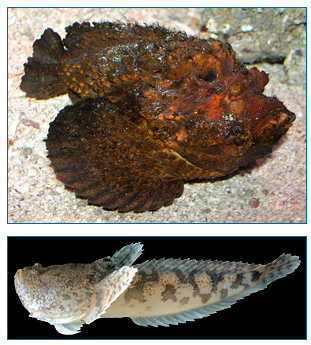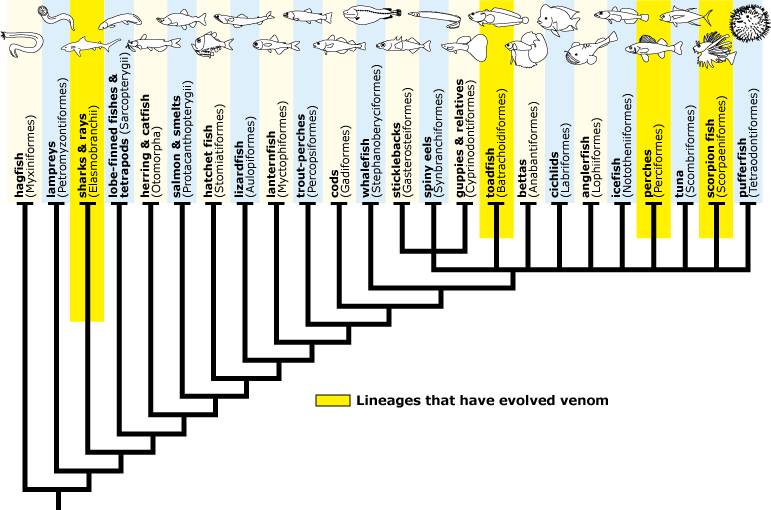
It’s second nature for most of us to avoid bees, spiders, and snakes because of their stings and bites. But what about fish? Swimmers in Australia are likely be on high alert for jellyfish, but how many are on the lookout for the stonefish, a member of the clade Scorpaeniformes (skor-PEE-nuh-FOR-meez) and the most venomous fish known to science? This Indo-Pacific fish masquerades as rocks or bits of coral, but anyone who steps on one will become instantly aware that this is no stone. The spines on the fish’s back deliver a potent neurotoxin, which can cause intense pain and, without treatment, even death.
The stonefish’s sting is among the worst of the bunch, but it is far from the only fish in the sea that delivers a venomous sting. Venomous ray-finned fishes cause about 50,000 reported injuries every year. By 2006, scientists had tallied around 200 venomous fish species but suspected that there must be many others. Since fish with venom don’t have a skull and crossbones tattooed on their backs, scientists would have needed to study each fish species — for example, by dissecting it and looking for a venom gland — in order to determine if it was dangerous. However, ichthyologists (IK-thee-ALL-uh-jists) Leo Smith and Ward Wheeler had a different idea about how to approach the question…
They reasoned that venom likely runs in families — that is, a fish that is closely related to a known venomous species is likely to be venomous also, while a distantly related fish is less likely to be venomous. To make their approach to identifying venomous fish work, the first thing they needed was a fish family tree to figure out how different species are related. They reconstructed the tree by comparing DNA samples from fish species throughout the Acanthomorpha (uh-KAN-thuh-MOR-fuh) — the spiny-rayed fishes. Then they mapped known venomous fishes onto the phylogeny. Venomous fish were scattered all over the tree. This suggests that venom has evolved multiple times in fish (in fact, 11 times!) and that there are likely lots of undiscovered venomous fish out there.
The researchers examined more than 100 fish species that were good candidates for being venomous based on the phylogeny. They found venom glands or tissue in more than half of them! Based on this result, the scientists estimated that there are probably more than 1200 venomous Acanthomorphan fish alone. A more recent study took a similar approach to studying venomous catfishes. Those biologists estimated there to be at least 1250 species of venomous catfish. If these estimates are correct, the number of venomous fishes in the world would outnumber all other venomous vertebrates!
This realization could be a boon to medical research. Animals use venom to defend themselves from another animal or to immobilize prey. Hence, all venoms are capable of affecting the cardiovascular, nervous, or muscular systems of animals. Such biologically active compounds are likely to have medical applications. For example, the venom of the pit viper was used to help develop the blood pressure drug captopril. While many researchers are investigating snake venoms for their pharmaceutical properties, fish venom is still an untapped resource. Who knows what medications might be developed from what we now know to be the thousands of venoms that have evolved in fishes!
The fish that we discuss here are venomous, but not poisonous. The two words have similar meaning with a slight difference. A venomous organism (like a snake) directly injects its toxin into another organism (e.g., with fangs or a spine or stinger). A poisonous organism (like the rough-skinned newt), on the other hand, has a toxin in some part of its body that only causes its toxic effects when touched or eaten.
Patlak, M. (2004). From viper's venom to drug design: treating hypertension. The FASEB Journal 18:421E.
Smith, W. L. and Wheeler, W. C. (2006). Venom evolution widespread in fishes: a phylogenetic road map for the bioprospecting of piscine venoms. Journal of Heredity 97(3):206-217.
Wright, Jeremy J. (2009). Diversity, phylogenetic distribution, and origins of venomous catfishes. BMC Evolutionary Biology 9:282

